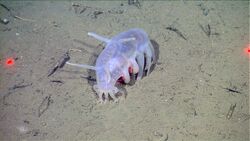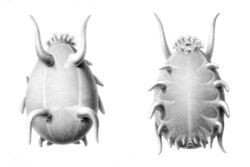Biology:Scotoplanes globosa
| Scotoplanes globosa | |
|---|---|

| |
| Scotoplanes globosa and symbiotic lithodid crab | |

| |
| Scientific classification | |
| Kingdom: | Animalia
|
| Phylum: | |
| Class: | |
| Order: | |
| Family: | |
| Genus: | |
| Species: | S. globosa
|
| Binomial name | |
| Scotoplanes globosa (Théel, 1879)
| |
| Synonyms | |
|
Elpidia globosa Théel, 1879 | |
Scotoplanes globosa, commonly known as the sea pig, is a species of sea cucumber that lives in the deep sea.[1] It was first described by Hjalmar Théel, a Swedish scientist. Scotoplanes globosa, along with numerous other sea cucumbers were discovered by Théel during an expedition on the HMS Challenger between the years of 1873-1876. Scotoplanes globosa was officially described in 1882, 6 to 9 years after its first sighting. Scotoplanes globosa is most closely related to the genus Peniagone.[2]
Ecology
Congregations of smaller Scotoplanes globosa are often observed on the ocean floor in groups of 10 to 30.[3] However, groups of Scotoplanes globosa have been observed to be as many as 600 individuals in one congregation. A congregation of Scotoplanes globosa is called a “trawl”. These groups of Scotoplanes globosa often appear to all be facing in one direction, into the ocean current. It is believed that this behavior aids S. globosa in the detection of the richest feeding sites. Scotoplanes globosa has also been observed to be the host of multiple deep-sea parasites, such as the small gastropods Stilapex and Crinolamia, and various parasitic crustaceans.[4] These parasites typically bore small holes into the body wall of S. globosa. Scotoplanes globosa are also often accompanied by a symbiotic lithodid crab, the Neolithodes diomedea.[5] It is believed that approximately 22% of Scotoplanes globosa are attended by at least one of these crabs.[5] At this time, scientists are unsure whether the relationship between S. globosa and N. diomedea is mutualistic or commensal.[5]
Anatomy
Scotoplanes globosa is typically 2 to 15 cm in length and appear to be a translucent white color.[6] S. globosa is covered in tube-like feet which are used in locomotion.[6] The tube-like structures found on top of the Scotoplanes globosa are also feet, as opposed to antennae. Scientists are still unsure whether these upper-tube-feet are used in locomotion or used as sensory accessories. They are quite buoyant and are easily displaced by strong currents.
Locomotion
Scotoplanes globosa has a soft, round body with five-to-seven pairs of long, tube-like limbs extending from its body.[6] S. globosa uses these limbs for locomotion. They “walk” along the ocean floor using muscle constrictions to push fluid in and out the tube feet cavities.[6] Scotoplanes is the only genus of holothurians that have been observed to "walk" in this manner.
Distribution and habitat
Scotoplanes globosa are found in almost all deep-sea regions in the world. Specifically, S. globosa live on the abyssal plain. They are commonly found off the coast of San Diego, as well as in the Arctic, Atlantic, Pacific, and Indian Oceans.[3] Scotoplanes globosa typically live at depths of over 1000 meters, and have been found in the deepest locations in the ocean.
Diet
Scotoplanes globosa is a deposit feeder, eating detritus which has sunk to the ocean floor. S. globosa has been observed to strongly prefer consuming fresh, recently fallen (approximately within the last 100 days) sediments on the surface of the ocean floor as opposed to older sediments.[7] These freshly-fallen sediments are more nutrient-rich. Scotoplanes globosa captures food through its mucous-covered tentacles which surround their mouth.[7] S. globosa is also known to congregate around the carcasses of whales which have fallen to the seafloor.[8] Lundsten et al. (2010) determined that S. globosa find deep-sea whale carcasses by smell, as well as other nutrient-rich food sources; the extremely nutrient-rich whale carcasses also attract other deep-sea creatures in large numbers.[8]
References
- ↑ "Sea Pig - Scotoplanes globosa - Overview - Encyclopedia of Life". http://eol.org/pages/599675/overview. Retrieved 2017-03-09.
- ↑ Takano, Tsuyoshi; Ijichi, Minoru; Itoh, Hajime; Fukuda, Hideki; Yoshizawa, Susumu (2018-11-26). "Complete mitochondrial genome sequences of a deep-sea holothurian species of the genus Scotoplanes (Elasipodida: Elpidiidae)". Mitochondrial DNA Part B 4 (1): 112–113. doi:10.1080/23802359.2018.1536462. ISSN 2380-2359.
- ↑ 3.0 3.1 Smith, Craig R.; Hamilton, Susan C. (September 1983). "Epibenthic megafauna of a bathyal basin off southern California: patterns of abundance, biomass, and dispersion". Deep Sea Research Part A. Oceanographic Research Papers 30 (9): 907–928. doi:10.1016/0198-0149(83)90048-1. ISSN 0198-0149. Bibcode: 1983DSRA...30..907S.
- ↑ Takano, Tsuyoshi; Itoh, Hajime; Kano, Yasunori (2018-07-03). "DNA-based identification of an echinoderm host for a deep-sea parasitic snail (Gastropoda: Eulimidae)". Molluscan Research 38 (3): 212–217. doi:10.1080/13235818.2017.1372865. ISSN 1323-5818.
- ↑ 5.0 5.1 5.2 Barry, James P.; Taylor, Josi R.; Kuhnz, Linda A.; De Vogelaere, Andrew P. (2016-10-15). "Symbiosis between the holothurianScotoplanessp. A and the lithodid crabNeolithodes diomedeaeon a featureless bathyal sediment plain". Marine Ecology 38 (2): e12396. doi:10.1111/maec.12396. ISSN 0173-9565.
- ↑ 6.0 6.1 6.2 6.3 Hansen, Bent (June 1972). "Photographic evidence of a unique type of walking in deep-sea holothurians". Deep Sea Research and Oceanographic Abstracts 19 (6): 461–IN3. doi:10.1016/0011-7471(72)90056-3. ISSN 0011-7471. Bibcode: 1972DSROA..19..461H.
- ↑ 7.0 7.1 Miller, Robert J.; Smith, Craig R.; Demaster, David J.; Fornes, William L. (2000-07-01). "Feeding selectivity and rapid particle processing by deep-sea megafaunal deposit feeders: A 234Th tracer approach". Journal of Marine Research 58 (4): 653–673. doi:10.1357/002224000321511061.
- ↑ 8.0 8.1 Lundsten, Lonny; Schlining, Kyra L.; Frasier, Kaitlin; Johnson, Shannon B.; Kuhnz, Linda A.; Harvey, Julio B.J.; Clague, Gillian; Vrijenhoek, Robert C. (December 2010). "Time-series analysis of six whale-fall communities in Monterey Canyon, California, USA". Deep Sea Research Part I: Oceanographic Research Papers 57 (12): 1573–1584. doi:10.1016/j.dsr.2010.09.003. ISSN 0967-0637. Bibcode: 2010DSRI...57.1573L.
Wikidata ☰ Q2490972 entry

